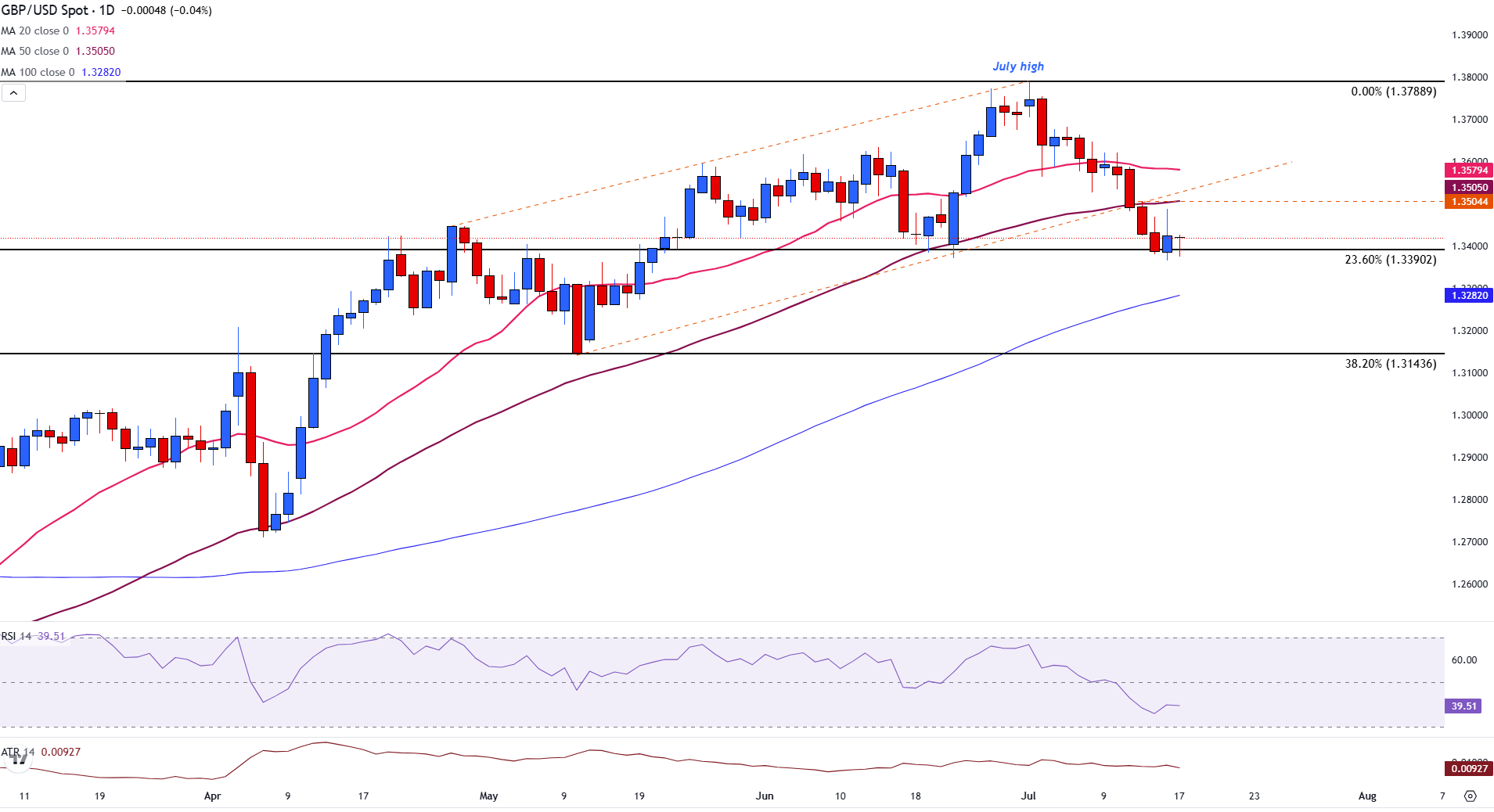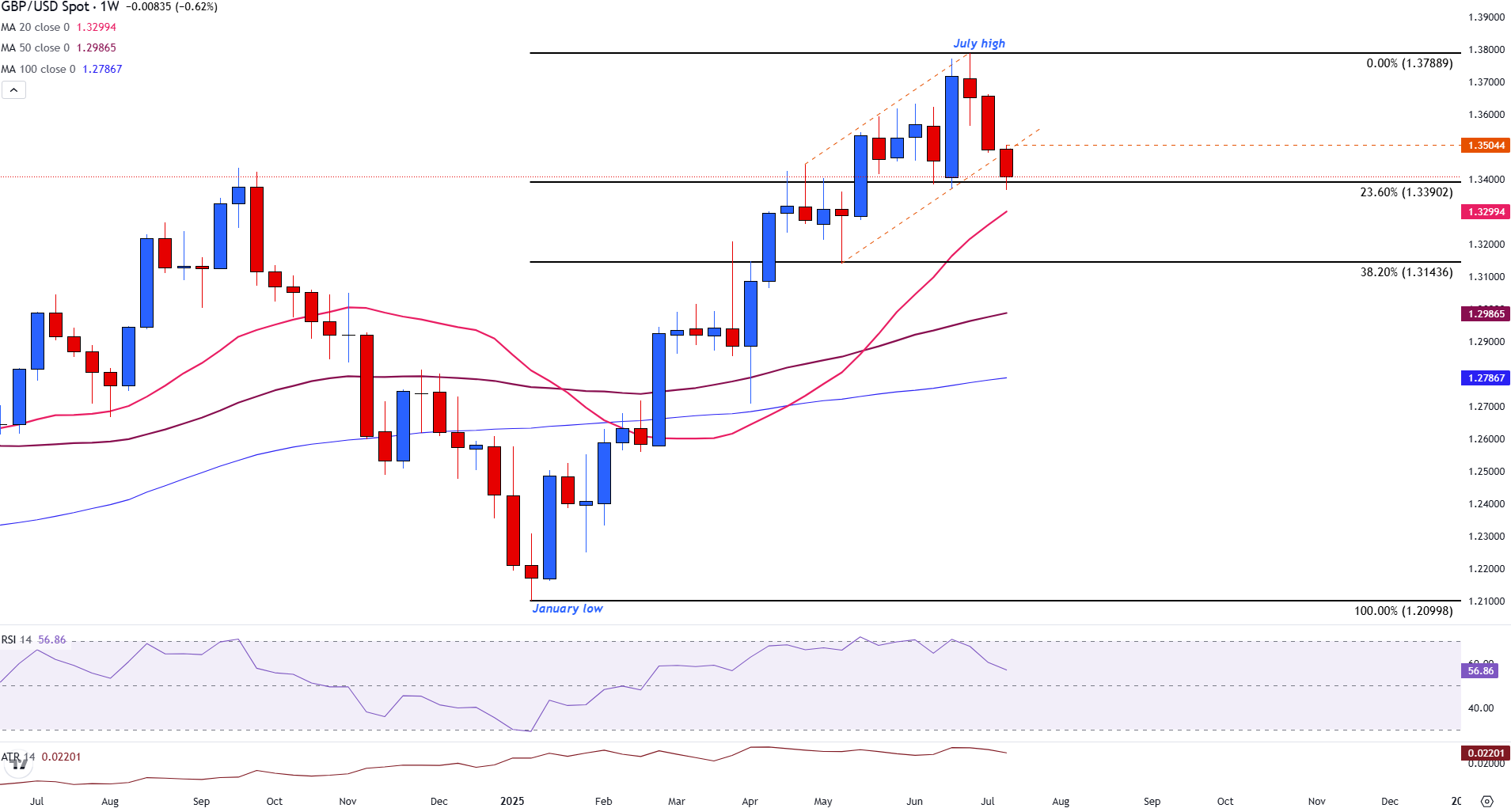- The GBP/USD breaks the channel support, but a doji candle in the daily chart reflects a temporary pause in the trend.
- Momentum indicators point out a potential for deeper correction as volatility is adjusted and the bulls struggle to recover control.
- The weekly GBP/USD graph suggests cracks in the medium -term perspective.
The GBP/USD is at a technical inflection point, a battlefield between the weakening of the bullish momentum and the growing bearish pressure. Thursday’s doji candle in the daily chart reflects a temporary pause, with the lack of body pointing out that buyers intervened to defend the 1,3390 –1,3370 region, despite the initial low pressure.
Although the candle has not yet closed, this type of price action often indicates a rejection of lower levels or at least a purchase interest that arises near the key support. It still does not confirm a reversal, but elevates bets for both sides.
The GBP/USD clings to a key support while sellers squeeze their control
The GBP/USD has broken below its ascending channel and is now floating above 1,3400, with an important support zone forming at the Fibonacci setback level of 23.6% of the Rally from January to July about 1,3390.
The price action is maintained below the resistance level of the Simple Mobile (SMA) of 50 days of 1,3505 and the 20 -day SMA in 1,3579, pointing out a remarkable loss of short -term bullish momentum.
The ruling to stay above the psychological level of 1,3500 and a break below the structure of the channel suggests that sellers are beginning to affirm their control.
Momentum indicators confirm the change. The relative force index (RSI) is currently around 39 and is approaching the territory of overalls, but has not yet arrived.
Meanwhile, the true average range (ATR) is around 0.00927, showing that daily volatility has compressed approximately 92–93 pips. When the ATR contracts, it often precedes a break, so operators must be attentive to an increase in volatility, especially close to key technical levels.
If the price breaks decisively below 1,3390, the next downward objectives are the 100 -day SMA in 1,3281, followed by the Fibonacci level of 38.2% in the area of 1,3144.
With the short -term trend pointing out that the sale pressure continues to accumulate, the bulls would need to recover the 50 -day SMA and overcome the 1,3575 area to change the feeling in the short term in their favor.
GBP/USD daily graphics

The weekly GBP/USD graph suggests cracks in the medium -term perspective
When making a zoom, the weekly GBP/USD chart confirms a clear bearish change. The strong rejection since July about 1,3789, marked by a long superior wick, was the first warning signal. The full -body bassist candle last week continued decisively, closing near the minimums in the channel support, reflecting a strong and sustained sales pressure. This was not just a setback, it was a clean downward movement.
The current weekly candle has a small lower wick after the bassists failed to break below the 23.6% Fibonacci level on Thursday. However, the full body of the candle is accumulating over the lower moving last week. The absence of a significant lower wick so far shows little resistance from buyers, reinforcing the idea that sellers have clear control at this stage. This is a classic bearish continuation, particularly worrying continuation since it is just formed in a critical support area around 1,3390.
If this price action is maintained until the weekly closure, it would mark a clean break below the fibonacci setback of 23.6% and could pave the path to deeper levels down, such as the 20 -week SMA in 1,3299, followed by the 38.2% setback in 1,3144. The momentum is clearly deteriorating, and the structure of this weekly candle makes it more difficult for the bullies to argue in favor of a short -term rebound, unless there is a significant reversal before the closing of Friday.
The Relative Force Index (RSI) weekly about 57 suggests that the broader trend remains intact, but the momentum is clearly weakening.
Weekly USD/GBP chart

With the GBP/USD keeping just above the critical support and compressed volatility, the pair is approaching a turning point, and the side that takes control could then define the direction during the next weeks.
LIBRA ESTERLINA – FREQUENTLY QUESTIONS
The sterling pound (GBP) is the oldest currency in the world (886 AD) and the official currency of the United Kingdom. It is the fourth most commercialized currency exchange unit (FX) in the world, representing 12% of all transactions, with an average of $ 630 billion a day, according to data from 2022. Its key commercial peers are GBP/USD, which represents 11% of FX, GBP/JPY (3%) and EUR/GBP (2%). The sterling pound is issued by the Bank of England (BOE).
The most important factor that influences the value of sterling pound is the monetary policy decided by the Bank of England. The Bank of England bases its decisions itself has achieved its main objective of “price stability”: a constant inflation rate of around 2%. Its main tool to achieve this is the adjustment of interest rates. When inflation is too high, the Bank of England will try to control it by raising interest rates, which makes access to credit for people and companies more expensive. This is generally positive for sterling pound, since higher interest rates make the United Kingdom a more attractive place for global investors to invest their money. When inflation falls too much it is a sign that economic growth is slowing down. In this scenario, the Bank of England will consider lowering interest rates to reduce credit, so that companies will borrow more to invest in projects that generate growth.
Published data measure the health of the economy and can affect the value of sterling pound. Indicators such as GDP, manufacturing and services PMI and employment can influence the direction of the sterling pound.
Another important fact that is published and affects the pound sterling is the commercial balance. This indicator measures the difference between what a country earns with its exports and what you spend on imports during a given period. If a country produces highly demanded export products, its currency will benefit exclusively from the additional demand created by foreign buyers seeking to buy those goods. Therefore, a positive net trade balance strengthens a currency and vice versa in the case of a negative balance
Source: Fx Street
I am Joshua Winder, a senior-level journalist and editor at World Stock Market. I specialize in covering news related to the stock market and economic trends. With more than 8 years of experience in this field, I have become an expert in financial reporting.







